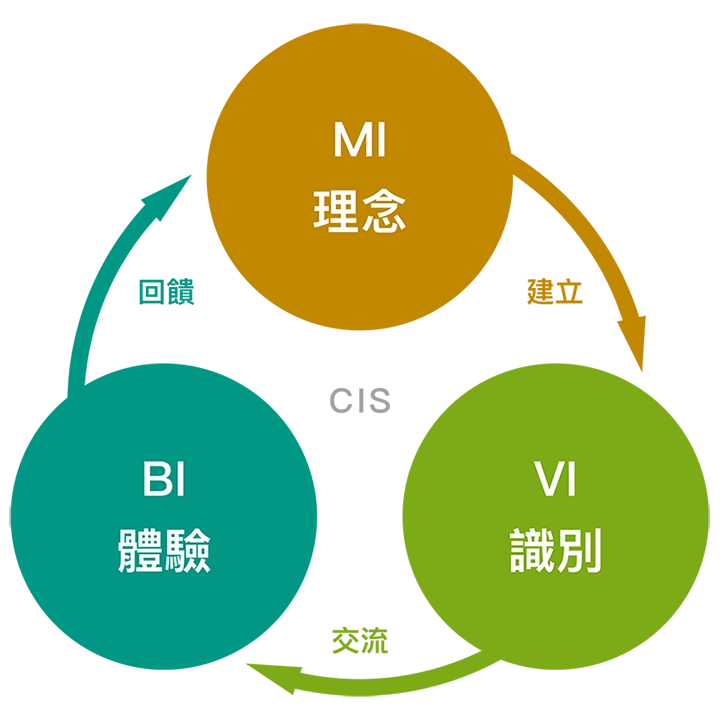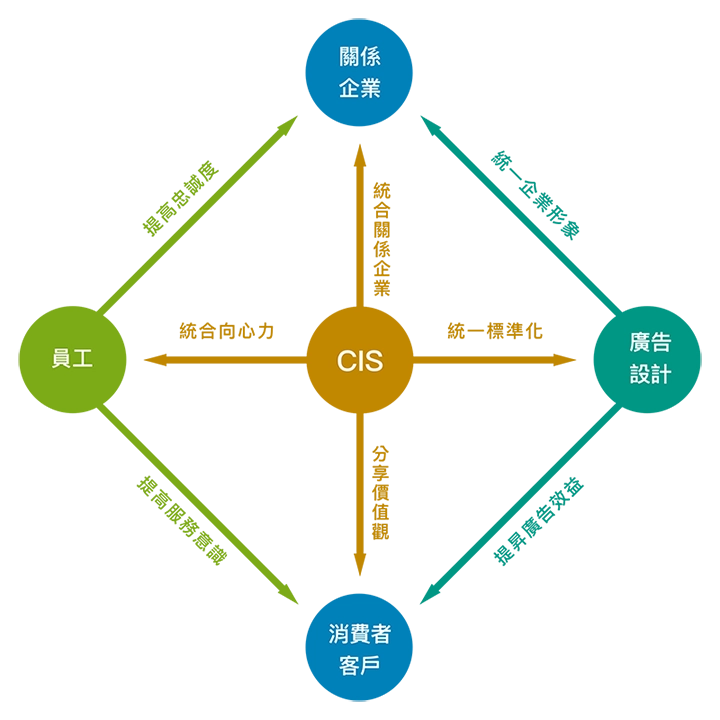CIS(Corporate Identity System)
The Corporate Identity System (CIS) is a comprehensive system designed to establish, maintain, and manage a company’s brand image. It encompasses the overall brand image, visual style, corporate culture, and the expression of brand values, aiming to create a unified corporate identity through a consistent visual and linguistic style. In today’s business environment, a brand’s identity and image are crucial to the success of a company.

CIS consists of three main components: MI, VI, and BI
MI(Mind Identity):
MI (Mind Identity) refers to the core values, mission, vision, and the internal spirit and culture of a company or organization. It involves the foundational beliefs and principles that guide the organization’s core ideology and behavioral standards. MI explains why a company exists, what goals it aims to achieve, and how it interacts with its stakeholders (such as customers, employees, partners, etc.). Through MI, a company can establish its unique identity, differentiating itself from competitors. It shapes the company’s long-term vision and provides clarity on how the company should behave, ensuring alignment between its actions, values, and overall business strategy. MI is critical in forming the cultural and strategic foundation of the organization, fostering a strong connection between the company and its stakeholders.
VI(Visual Identity):
VI (Visual Identity) refers to the visual representation of an organization, including elements like logos, colors, fonts, graphic elements, and other visual components. These elements are consistently applied across various media, such as product packaging, advertisements, promotional materials, and website design, to create a cohesive brand image. Through VI, a company can establish a unique and consistent visual identity that allows people to quickly recognize and remember the brand. It helps create a strong, memorable impression, fostering brand recognition and reinforcing the company’s values and image in the minds of its audience. A well-crafted VI ensures that the brand’s visual elements are aligned with its core values, mission, and target market, building trust and credibility over time.
BI(Behaviour Identity):
BI (Behavioral Identity) emphasizes the organization’s actions, attitudes, and communication style, as well as its interactions with stakeholders, including customers, employees, and partners. This includes aspects such as the company’s service attitude, problem-solving approach, and the work ethic of its employees. Through BI, a company ensures that its behavior and attitudes align with its MI (Mind Identity) and VI (Visual Identity), creating a unified and consistent brand image. When the organization’s actions reflect its core values and visual identity, it builds trust and credibility with its stakeholders, reinforcing the overall brand perception. A strong BI fosters positive relationships with customers, enhances employee satisfaction, and contributes to long-term brand success.
Exactly! CIS integrates MI (Mind Identity), VI (Visual Identity), and BI (Behavioral Identity) to create a cohesive and unique brand image. By combining the core values, visual elements, and communication behaviors, CIS helps a company build a strong and unified identity in the market. This integration ensures that the company is easily recognizable, memorable, and able to enhance its brand value and influence.

CIS Identity System Components
The CIS (Corporate Identity System) consists of multiple elements that work together to form a company’s unique identity. The main components include:
Logo:
The corporate logo is the most fundamental and visually direct element of a company’s identity. It typically consists of a simple and clear graphic combined with text, representing the brand image and core values of the business.
Color Palette:
Specific colors can give a company a unique visual style and emotional connection. The CIS identity system defines a set of primary colors and color schemes to be used consistently across all of the company’s visual designs.
Typography:
Specific fonts and typography styles are also important components of corporate identity. The CIS identity system defines appropriate fonts and typographic standards to be used in the company’s written communications and designs.
Slogan:
Express the company’s core values, mission, and vision in the form of copywriting, to be used in promotions, advertisements, and other communications.
Graphic Elements:
In addition to the logo, a company may also have specific graphic elements that help extend and enrich the visual style of the brand.
Corporate Imagery:
Corporate image photos refer to the images and visual content used by a company that align with its brand identity. These are utilized in various promotional, advertising, and media materials.
Document:
Standardized templates for documents such as letters, reports, and business cards are used to ensure consistency in brand identity.
Advertise:
Design and usage guidelines for promotional posters, advertisements, and social media images.
Package:
Design guidelines for product packaging to ensure consistency with the brand identity.
Website:
Determine the design style, layout, and image usage for the company’s website.
Usage Guidelines:
To ensure consistency and integrity of the brand image, the CIS identity system establishes usage guidelines and standards for various elements such as the company logo, colors, fonts, and others, for reference by both internal and external personnel.
Employee Training Manual:
Introduce the company’s brand image and behavioral guidelines to help employees understand how to represent the company.
The role of the CIS identity system
Establishing a brand image:
The CIS identification system helps businesses establish a unique and recognizable brand image, allowing consumers to quickly identify the company and enhancing the brand’s recognizability and memorability.
Enhancing brand value:
A unified and consistent brand image can enhance the brand’s value and credibility, fostering trust and loyalty among consumers.
Enhancing the competitiveness of the company:
An organized CIS identification system can help companies gain a competitive edge in the market, creating a clear differentiation from their competitors.
Conveying corporate culture:
The CIS identification system is not just a visual style; it can also convey the company’s culture, values, and sense of mission through elements such as logos, colors, and fonts.
Enhancing employee cohesion:
The CIS identification system can also have a positive impact within the organization, enhancing employees’ sense of belonging and cohesion, and improving work enthusiasm and efficiency.
